
A student of mine was at an equine expo watching the various demonstrations and clinics. Afterward, she sent me a note; “Not one clinician told their students to look up and away from the horse. Is that [looking ahead of your horse] just an Andy-ism?”
My reply; “Not an Andy-ism, just a global world truth about the human body, and how it operates… one that many in the horse world seem to ignore.”
Open up just about any horse publication and you can see riders and drivers staring fixedly at their horses. It’s a tough habit to break. After all, there you are, with your horse, trying to improve his movement, so you kinda want to “see what you are doing.”
Worse yet, there are instructors in the world who are actively telling their students to look at their horses. This is nothing less than destructive to the student and horse’s learning process. It isn’t only poor form, it inhibits effective communication with the horse.
The Head Follows the Eyes, the Body Follows the Head
The eyes are the first component in establishing a good position. When I speak of “a good position”, it’s not in reference to what looks “correct.” It’s in reference to what is effective. Your head follows your eyes, and your body follows your head. That means if you are staring at your horse, your head will tilt forward, and the shoulders will follow suit. Once your shoulders roll forward, you begin to pitch forward in your seat.

As your body tips forward, the muscles of the back must engage to maintain the position. That slouched position locks up the shoulders and elbows, making them less flexible. You also give up valuable leverage and stability which takes away from your clarity of communication.
All of these factors reduce your quality of contact, not only for your communications to the horse but in your perception of the communications returning to you through the reins. Since your back and shoulders are already flexed to maintain this body position, you perceive that the horse is heaver in the reins than he actually is. With horses that are in fact heavy in the reins, you’ll be sure they are trying to pull you out of the carriage.
At the other end of the spectrum, if your horse is light in the reins, you’ll often lose contact without even knowing it. If your instructor is constantly begging you to take more contact, when you are sure you’re already using too much contact, your body position may be part of the problem.
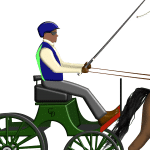
Picking the eyes up to a focal point well ahead of your horse brings your chin up. That doesn’t automatically correct your whole body position, but it makes sitting in better position easier. You will still have to remember to rise from your chest, then roll your shoulders up and back to put yourself in a more effective body position. Finally, a slight tip back secures your position in the carriage and improves leverage to allow your communications to transmit through the reins loud and clear.
Of course, there are more good reasons to raise your focal point.
Yesterday’s News
Watching the horse as he moves is like reading yesterday’s news. What you see between the shafts is simply the result of something that you already did or communicated to the horse. It is your horse’s reaction to what just happened.
Yet, when you watch your horse, it’s almost impossible for you to not react to what your horse is doing at that moment. If your horse shows tension, you’ll react with tension. If he begins to over-flex, or counter-bend, you can’t help but try to fix that then and there.
On top of that, you are not focused on the movement to come. Instead of showing your horse where his balance should be for what he is about to do, you’re trying to fix his balance in the moment. Now you are literally driving or riding in the past because you are reacting to your horse’s reaction!
When you put your focal vision on the place you are trying to go, your reflexes become tuned to getting to that place in the world. You notice the moment the horse begins to move in a way that doesn’t support your goals. If there is a movement that doesn’t support reaching that place, your body responds instantaneously with a course correction. When things are going well, your body relaxes avoiding any interruptions getting where you intend to go.
“But Andy, how am I going to know what my horse is doing if I don’t look at him?”
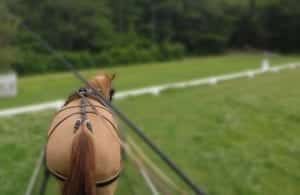
Whether you are sitting in a carriage or sitting in the saddle, you can see your horse no matter where you’re focusing your vision. Just about anywhere you look, your peripheral vision is still taking in what your horse is doing. In fact, your peripheral vision takes in far more detail than you give it credit for.
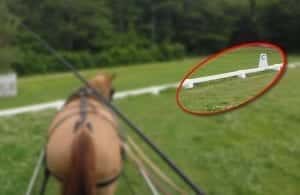
When I’m teaching my students about this, I like to do a little experiment with them. While the horse is standing, I walk to a place in the ring about 70º off to the driver’s side away from their horse. I ask the student to look me in the eye, then tell me what their horse is doing. They can see which direction the horse’s head is facing or if he raises his head and they can even see if he shifts his balance as he rests a foot.
All of the information about what your horse is doing is entering your awareness through your peripheral vision 100% of the time you are driving or riding. The great thing is, that information bypasses the messy and often inaccurate cognitive thought process. It plugs directly into your nervous system allowing your subconscious coordination to handle things. That part of your nervous system is much better at small, subtle corrections and adjustments. It also allows you to focus more clearly on what you’ll want your horse to do in the next moment.
Checking In
Of course, you are going to look at your horse from time to time. It’s almost impossible not to. You certainly can look through this website and find plenty of pictures of me with my eyes on the horse! A glance here or there is useful and necessary. But don’t let your horse be your focal point. You can accomplish much more by putting your eyes where you want to go next.
Focused Practice
To overcome this frustrating habit, you need to set some time aside to practice the skill of looking away from your horse. Using lesson plans that are designed to get your attention ahead of the horse will help.
You can even get started by simply improving your driving position long before you get your horse out of the barn. That lesson plan has 3 simple exercises that you can do anytime, anywhere to help get your body to automatically hold itself in a better position. The 4th exercise helps you transition that body position to the carriage while driving your horse.
The Zen Circles lesson plan was written almost entirely to address the the driver’s point of focus. It’s a really relaxing lesson plan for both the driver, and the horse. I love driving that lesson plan when I really need unwind.
The most fun of the three lesson plans in the Cones Field Goal. It’s a great exercise for really looking ahead through the cones pattern while you’re driving it.
When It Comes Together
Getting your eyes in the right place when you drive will start a chain of events that ends with a pleasurable and successful drive. Your driving position will improve, thus allowing your hands and arms to be supple. Your intention will be focused on what you are trying to accomplish, rather than what is going wrong. Small adjustments spurred by non-cognitive thought will replace reactive driving or riding.
Your horse will respond better to your more accurate communications. In the end, you will be a safer equestrian who gets to enjoy a whole lot more of the joy of carriage driving or riding.
Add Your Thoughts and Questions
Did everything make sense to you here, or is there something I missed?
Was there a time when you were driving that where you were looking made the difference between success and… well, not so much success?
Share your experiences or questions in the comments section at the bottom of the page.
Related Posts
 How Much Contact For Carriage Driving? - I’m often asked, “How much is too much contact, and how little is too little.” The answer often depends on what it is that you’re doing with your horse. But the question of how much contact you should use goes beyond the specific activity your are doing with your horse. It can change within the… Continue Reading
How Much Contact For Carriage Driving? - I’m often asked, “How much is too much contact, and how little is too little.” The answer often depends on what it is that you’re doing with your horse. But the question of how much contact you should use goes beyond the specific activity your are doing with your horse. It can change within the… Continue Reading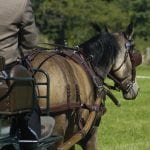 Activating The Rein - Your reins are your primary communication device when driving your horse or pony in the carriage. So how you use those reins is of critical importance. Here are some tips on how to make those communications come through loud and clear to your horse. Continue Reading
Activating The Rein - Your reins are your primary communication device when driving your horse or pony in the carriage. So how you use those reins is of critical importance. Here are some tips on how to make those communications come through loud and clear to your horse. Continue Reading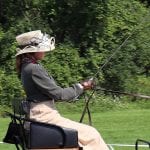 Finding Stillness - Probably two-thirds of the information passed between the driver and the horse is transmitted through the reins. It stands to reason that the more clearly and accurately we can handle the reins, the clearer and more accurate our communication will be. That’s where being able to achieve stillness on the reins is critical. Of course,… Continue Reading
Finding Stillness - Probably two-thirds of the information passed between the driver and the horse is transmitted through the reins. It stands to reason that the more clearly and accurately we can handle the reins, the clearer and more accurate our communication will be. That’s where being able to achieve stillness on the reins is critical. Of course,… Continue Reading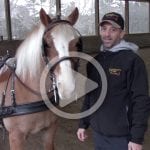 Improve Your Body Mechanics - Sometimes it’s easy to forget that how you’re using your body on the carriage effects how your horse is moving. After all, you’re fairly isolated from the horse, and you’re sitting 3-4 feet behind him. But small changes in your body can make big differences in your horse’s way of going. Here's a short video… Continue Reading
Improve Your Body Mechanics - Sometimes it’s easy to forget that how you’re using your body on the carriage effects how your horse is moving. After all, you’re fairly isolated from the horse, and you’re sitting 3-4 feet behind him. But small changes in your body can make big differences in your horse’s way of going. Here's a short video… Continue Reading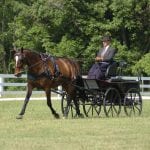 Half Halts and Transitions - Most people think of transitions as that moment when your horse goes from one gait to another, such as a walk to a trot. However, that interpretation sells the importance of transitions short and also explains why so many people and horses have difficulty with their transitions. A transition should be viewed as a multi-phase… Continue Reading
Half Halts and Transitions - Most people think of transitions as that moment when your horse goes from one gait to another, such as a walk to a trot. However, that interpretation sells the importance of transitions short and also explains why so many people and horses have difficulty with their transitions. A transition should be viewed as a multi-phase… Continue Reading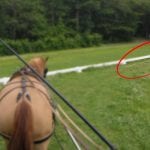 Looking Ahead - A student of mine was at an equine expo watching the various demonstrations and clinics. Afterward, she sent me a note; “Not one clinician told their students to look up and away from the horse. Is that [looking ahead of your horse] just an Andy-ism?” My reply; “Not an Andy-ism, just a global world truth… Continue Reading
Looking Ahead - A student of mine was at an equine expo watching the various demonstrations and clinics. Afterward, she sent me a note; “Not one clinician told their students to look up and away from the horse. Is that [looking ahead of your horse] just an Andy-ism?” My reply; “Not an Andy-ism, just a global world truth… Continue Reading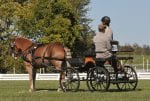 The Step Back - Many carriage drivers struggle with their horse taking a step backward after completing a halt. Understanding why the horse is taking the backward step is the first step toward solving the problem. Continue Reading
The Step Back - Many carriage drivers struggle with their horse taking a step backward after completing a halt. Understanding why the horse is taking the backward step is the first step toward solving the problem. Continue Reading Excessive Use of the Whip - What constitutes “excessive use of the whip?” As carriage drivers, one of our most valuable communication aids is the whip. In fact, it’s so important that we are required to have the whip in hand anytime we are driving in a competition. Like any tool, it can be misused. The American Driving Society lists “excessive… Continue Reading
Excessive Use of the Whip - What constitutes “excessive use of the whip?” As carriage drivers, one of our most valuable communication aids is the whip. In fact, it’s so important that we are required to have the whip in hand anytime we are driving in a competition. Like any tool, it can be misused. The American Driving Society lists “excessive… Continue Reading
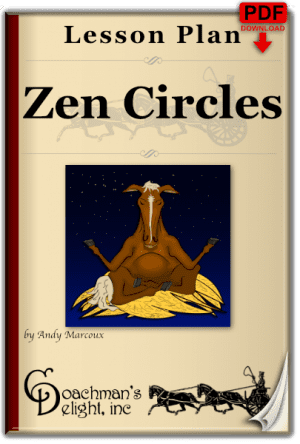
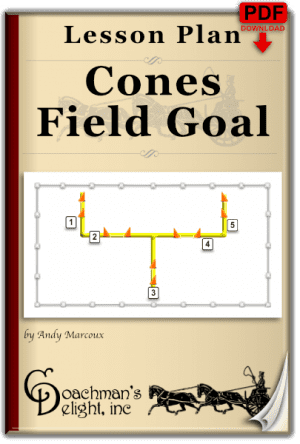
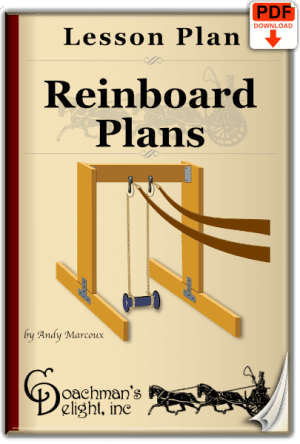
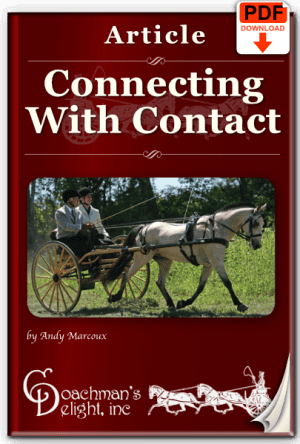


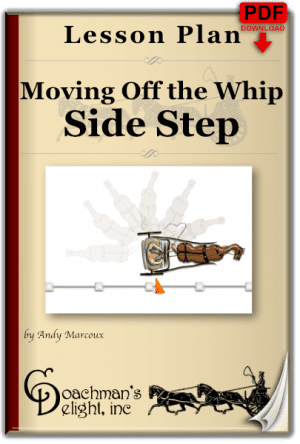


Hi. Just browsing,,,half an hour ago! All makes sense. Just beginning long lining. No harness or carriage yet. Rode in the past.
If you drive a car, it is nor safe to watch the bonnet! If walking or running, it is not safe to watch your feet.
All makes sense. !!
I will be returning to this often, thank you.
Wonderful reminder… I cannot wait to play with this idea with driving my mare… but today we rode in some snow covered fields and made sure my focus was further ahead… Thank you… this really helped me help prepare my horse so much better for the athletic demand that was coming up much better… I apparently was slipping into focusing to closely on us and… yes! It to late to fix what is already happening! And I know better! My mare was happier and even ponying my filly with us… the whole ride was much smoother and we all felt prepared for the next “turn”, “Hill”, gait change etc… Thank you for the reminder! Now to try it the next time we drive… We are new to the carraige driving world, and because I am not as experienced, I am sure my focus is not for enough ahead which could be the cause of some our issues… Can’t wait for our next drive! ♥️
Thanks for the note Bonny!
I love to see that something that I’ve shared has made a difference and made you look forward to your next drive.
This is something I try to convey when teaching riding and driving. The analogy I use is that you never look at the bonnet/hood of a car when your driving – you’ll crash, so why look at the horse while your riding/driving?
Lifting your eyes lifts your chin, opens up your chest, allowing you to breath better and relax. You relax and your horse feels it down the reins and they become less stiff and the communication is just so much better.
Your head follows your eyes, your body follows your head.
I was taught this when learning to drive a car. Focus as far down the road as you can, and your driving smooths out, and becomes much less “busy.” You make all the small corrections without even thinking about it. It’s just as true with riding or driving a horse. The one thing I feel I have to do is make sure of the footing for the horse ahead of time so I’m not having to watch for gopher or woodchuck holes.
Very true. Pretty much in just about any activity or sport, getting your eyes ahead will smooth things out. And don’t worry, your horse see’s more of the footing than you think. They’ve usually spotted the poor footing before we even know it’s there!
Andy does this apply to cone driving too?
Absolutely Susan! Even more than when you are doing ring work. Putting your vision, attention, and intention well ahead of your horse is critical to driving through any sort of obstacles. Look where you want to go rather than at what you don’t want to hit!
Great article Andy!
I struggle with this while driving my pony. Do you have any exercises that you suggest to help me get my focus where it belongs?
Hi Melodie,
You might like the Zen Circles lesson plan that I posted recently. That lesson plan is very much geared toward getting your focus and attention way ahead of where you’re driving.
Once you’ve played with that a little, set up the Field Goal exercise, with the Zen Circles in mind. IT’S REALLY FUN!!
Keep up the good work! I am finding your online seminars as well as videos and articles so informative! Thank you!